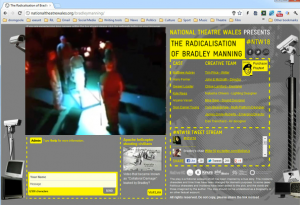
During April 2012, National Theatre Wales produced an important new play about Bradley Manning, the alleged Wikileaker who spent some of his early teenage years living in Haverfordwest in West Wales. NativeHQ designed and ran the multiplatform element of the production, in which we produced a global live stream of the play during every one of the live performances.
NTW’s Artistic Director, John McGrath, got NativeHQ involved very early in the development of the production, as writer Tim Price was developing his early drafts. We had a chance to think through the various options for placing the play into online spaces and settled on the live streaming concept, using surveillance cameras built into the set.
Tim wanted whatever we did to point to Bradley Manning, so we conceived of a web page which would go beyond simple live streaming to include live chat among virtual audience members and links that connected what was happening on the live stream with source material such as new stories, weblogs, interviews and even an archive of the website that Bradley created during his time in Wales.
Being integrated into the creative team provided us with an important opportunity to work with the very talented team putting together the show. Kudos should go to Producer Lucy Davies, Production Manager David Evans and Assistant Producer Michael Salmon , designer Chloe Lamford, Lighting Designer Natasha Chivers, sound guys Mike Beer and Matt Gibson, techie Jacob Gough, Stage Managers Fiona Curtis and Gemma Thomas, Costume supervisor Jo Nichols and AV designer Dan Trenchard. And of course Hoffi, who co-ordinated the website build, and Kinura who managed the live streaming infrastructure. Wales is lucky to have an impressive theatre community and tradition emerging here under John’s guidance.
Learning about theatre and multiplatform
There was a huge amount of learning about the process of theatre co-creation and how multiplatform production can find a place within this process. The big lessons are around time, budget and working closely with all those who are affected by the multiplatform work – it’s often new to theatre practitioners and going through the implications for their work can often take time and careful explanation.
The live streaming wasn’t without its technical problems – the last performances in Connah’s Quay, which were run by Carl, faced the challenge of a complete shut down of internet accessibility by the council, which seemed to have closed for the weekend. Carl and Michael Salmon stepped up to this by livestreaming the show to the world via a 3G connection through Mike’s smartphone – impressive stuff, that hopefully none of the audience noticed.
In total, about 9000 people from over 70 countries around the world accessed the livestream, and it got wide coverage – it was tweeted by Wikileaks as well as the Bradley Manning Campaign, and a couple of theatre reviewers took the time to review the online experience, as distinct from the corporeal show. Dylan Moore from the ArtsDesk called it the ‘cutting edge of theatre’, while Daniel B Yates for Exeunt magazine used the opportunity to discuss the use of the internet in theatre and the nature of ‘Liveness’. Both reviewed gave the online experience four stars.
Reflections on live streaming theatre and immersion in web storytelling
Unlike physically live theatre, the use of live stream displaces the viewed by physical location and interaction. We become voyeurs. We played on this, and the themes of the story, by using the aesthetics of surveillance cameras. We also wanted to deepen the viewers immersion in Bradley’s story by offering them places to go through the links that were put onto the site during the show.
This was also important as it gave the viewed some measure of control over their own experience while keeping them in Bradley’s story – the web is a user centric, active medium, with that google search bar sitting at the top of the web page, making it easy to leave if the viewer is bored or distracted. In a theatre space, they are physically constrained, making it easier to hold attention. Adapting the story effectively to the web meant thinking carefully about the nature of the web medium and working to take advantage of its character in the multiplatform design.
The web offers new interactive possibilities to theatre makers, and we chose to take full advantage of the liveness in time that streaming offers, while thinking carefully about the way context collapses – viewers encountered it in offices, cafes, living rooms, kitchens or bedrooms. It was important to enable people to not only follow along, but share, comment, speak back, write and create themselves.
NTW18 was the latest in our journey of experimentation with multiplatform technology and John McGrath’s National Theatre Wales. It’s a journey that has taught everyone involved invaluable lessons on what is possible, what is involved in creating virtual spaces that work together with physical spaces, and the potential of the internet as a vehicle for storytelling and live multiplatform experiences.